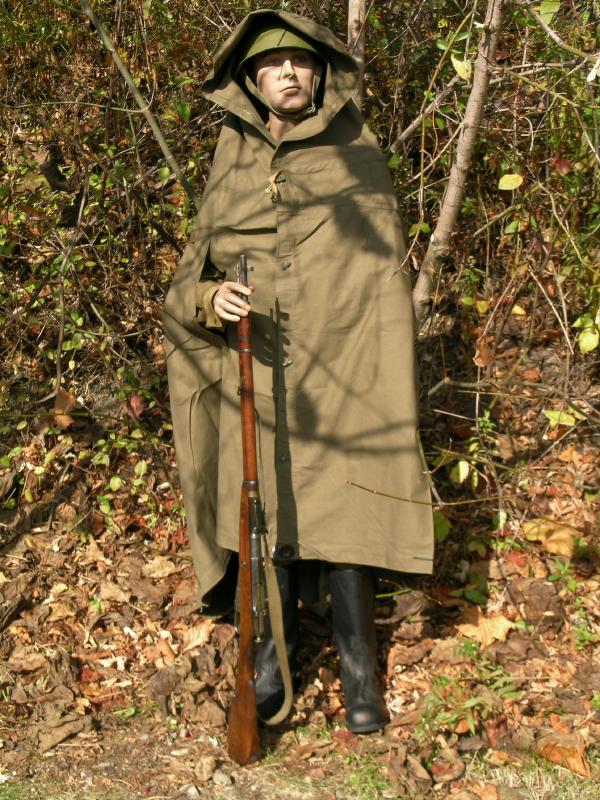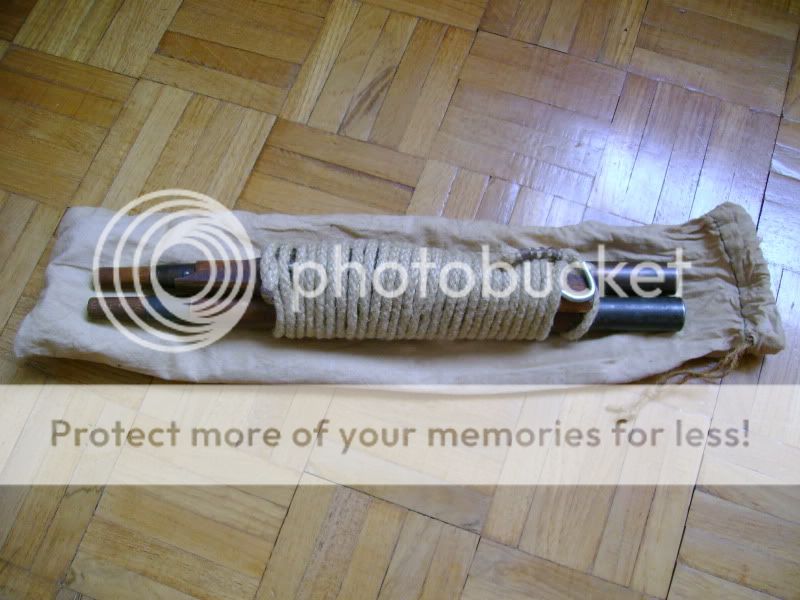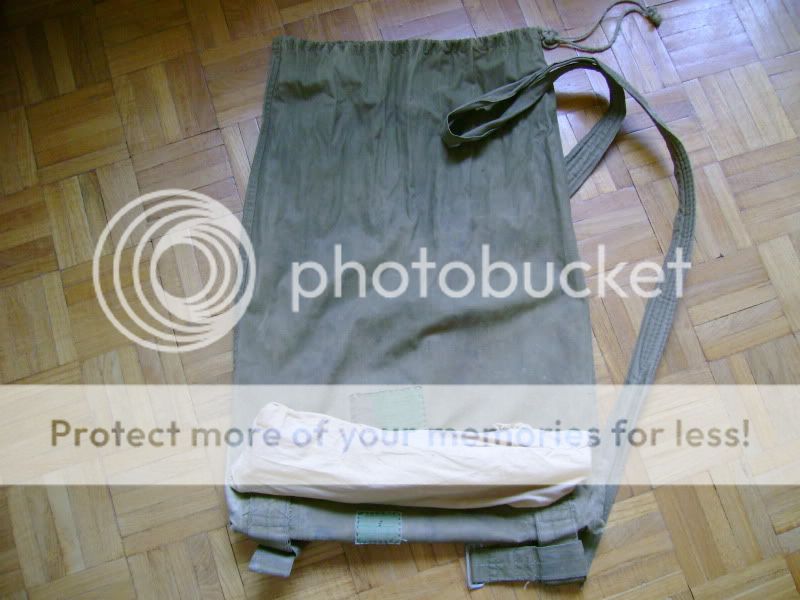As is now an established tradition, the Friday post will be a little more diverse than usual (Although yesterday we had a bomb thrower that used biscuits to work!).
I have been reading a little about the Battle of Berlin (the 1945 one). This lead me to look at Soviet infantry equipment.
In military circles “simple and effective” is often synonymous with “Russian”. The Soviet solder did not seem to carry very much, but what he did carry was surprisingly well thought out. Reducing the soldier’s load is a long running topic of debate so it is worth having a look at how the Soviets approached this. This is going to be just a quick thumbnail sketch of Soviet equipment so for brevity I will not go into great depth. There are many fine websites that can give you details such as introduction dates, model numbers, variations and so forth.
The first thing that becomes apparent is that some of the infantry equipment was very similar to that of the German soldier. Of course, during the war a lot of German equipment was used by the Soviets and the similarities often do not make this obvious in photos. Many readers will be familiar with German belt order items so for convenience I will refer to these for purposes of comparison.
The first thing you notice when comparing the German and the Soviet is what is not there. The German routinely carried his mess tin and breadbag on his belt. Sometimes the mess tin was attached to the yoke or a backpack but carry on the belt was very common. The Soviet seems to have preferred to carry his mess tin in his backpack or tied to the outside. The Soviet mess tin was a kidney section pail of similar design to the German. An older pattern of circular pail was also in use. There was a Soviet version of the breadbag but it does not seem to have been so widely used. Again the Soviet seems to have preferred to carry his rations and personal items in his pack. The breadbag may placed inside the pack rather than being worn on the belt.
Another “missing” item is the bayonet scabbard. The German usually placed his bayonet over his entrenching tool. The Soviet rifle used a socket bayonet that was kept permanently attached to the rifle. The standard bayonet had a screwdriver tip for adjustment of certain parts of the rifle. It was also a handy implement for clearing a jammed cartridge. Some other Soviet weapons had folding bayonets. No bayonet scabbard was issued in wartime since they were not needed. Bayonet scabbards tend to be all metal and on the heavy side in my experience, so this policy may have saved the Soviet soldier a few ounces of unnecessary weight. While the bayonet was a useful fire poker, screwdriver, pot lifter and candlestick it was not much use as a utility knife. Scouts and some other troops might carry the NR-40 knife. Other blades such as German trench knives or Finnish puukot might also have been carried.
An iconic equipment item of the German soldier is the metal canister used to carry his gas mask. The Soviet equivalent was a canvas bag carried near the left hip. Once it was accepted that gas warfare was unlikely Soviet soldiers often did not bother to wear this bag. Some removed the gas protection equipment and used the bags for more useful items.
So what did the Soviet soldier carry? There would be an ammunition pouch. At the start of the war a pouch was worn each side in the same fashion as a German soldier. Reenactor websites I have viewed are insistent that it became routine to wear just one ammunition pouch, which was positioned on the right of the belt. A grenade pouch was usually worn on the left side. The belt would also carry a water bottle.

The final belt item was an entrenching tool. The German soldier seems to have favoured carrying this on his left side, sometimes towards the rear. In contrast the Soviet carried his on the right side. A dense items such as an entrenching tool might injure the wearer if it was fallen upon so the Soviet e-tool was on the flank, with the ammunition pouch preventing it creeping forward. Alternately the tool was tied to the pack. If the tool was expected to be urgently needed for close combat it might be tucked through the front of the belt. Several designs of carrier were used for the e-tool. The simplest and most interesting is the one shown below. The shaft is passed through a loop and a flap used to secure the top. The flap is fastened by a button, toggle or popper. It is both a quick draw and minimum weight solution!
The Soviet’s kit was not limited to what was on his belt. We have mentioned his backpack several times and have discussed the design of this item in another blog. The classic image of the Soviet soldier has him with a blanket roll across his chest. In actual fact this item is a rolled greatcoat. Russian soldiers were not issued blankets and were expected to use their greatcoat to sleep under. Note that the rolled greatcoat was always worn from the left shoulder to the right hip so that the rifle or SMG could be properly fired from the right shoulder. Alternately the greatcoat horseshoe was tied around the outside of the pack.
Another important item was the shelter cape or “Plash-palatka”. This was rather ingenious square of cloth that served as basha-sheet, tent component and rain cape. As can be seen, this is a 180cm square of canvas with button holes in each edge and grommets at the corners. One side has toggles next to the button holes (top edge in diagram). There is a single arm slit near this side. One corner (top left) has two drawcords in channels. Not shown in the diagram is that there is a toggle sewn some distance toward the centre from the bottom right corner. When worn as a rain cape the toggle is passed through the bottom right grommet to prevent this corner trailing on the ground.
When used as a rain cape the drawcords are pulled in to form that corner into a hood. The opposite corner is folded up and secured as described in the previous paragraph. The right arm is passed through the arm slit to operate the weapon. The left arm comes through the front opening of the cape but maintains a good drape of cloth over the left side to keep off the rain and provide concealment. This really is a well thought out design!
The Plash-palatka on its own could be used as a shelter or combined with others to form a variety of structures. Some of these are illustrated in the Russian manual. The preferred method of joining them appears to be lacing them together through the button holes. This may be because only one side had toggles and this side would have to be placed lowest to prevent rain entering through the fly of the arm slit.
For turning the Plash-palatka into a shelter the soldier also carried two sections of tent pole, a wooden peg, a metal peg and four foot of guy rope. This could be compactly stowed in a small back and the resulting package was the right length to fit widthwise in the backpack! It could also be tied to the outside of the pack if interior space was limited.
The Plash-palatka might be carried folded up inside the backpack. If the rolled greatcoat was carried it might be rolled around the greatcoat to keep it dry. When the greatcoat was not carried the Plash-palatka might be rolled up and carried from the left shoulder to the right hip in the same fashion that the greatcoat was. The folded item might also be carried attached directly to the yoke straps as is shown in an earlier photo.
My researches also brought me to the combat load of a cold-war era Soviet Motor Rifleman. Very little has changed! The design of ammunition pouch is different to suit the AKM and a bayonet in a scabbard is now worn. The gas mask case is back and a rolled NBC suit is attached to the yoke, just above a shelter cape.
If you have enjoyed this article or it has been helpful to you please feel free to show your appreciation. Thank you.
The Books
I have been reading a little about the Battle of Berlin (the 1945 one). This lead me to look at Soviet infantry equipment.
In military circles “simple and effective” is often synonymous with “Russian”. The Soviet solder did not seem to carry very much, but what he did carry was surprisingly well thought out. Reducing the soldier’s load is a long running topic of debate so it is worth having a look at how the Soviets approached this. This is going to be just a quick thumbnail sketch of Soviet equipment so for brevity I will not go into great depth. There are many fine websites that can give you details such as introduction dates, model numbers, variations and so forth.
The first thing that becomes apparent is that some of the infantry equipment was very similar to that of the German soldier. Of course, during the war a lot of German equipment was used by the Soviets and the similarities often do not make this obvious in photos. Many readers will be familiar with German belt order items so for convenience I will refer to these for purposes of comparison.
The first thing you notice when comparing the German and the Soviet is what is not there. The German routinely carried his mess tin and breadbag on his belt. Sometimes the mess tin was attached to the yoke or a backpack but carry on the belt was very common. The Soviet seems to have preferred to carry his mess tin in his backpack or tied to the outside. The Soviet mess tin was a kidney section pail of similar design to the German. An older pattern of circular pail was also in use. There was a Soviet version of the breadbag but it does not seem to have been so widely used. Again the Soviet seems to have preferred to carry his rations and personal items in his pack. The breadbag may placed inside the pack rather than being worn on the belt.
Another “missing” item is the bayonet scabbard. The German usually placed his bayonet over his entrenching tool. The Soviet rifle used a socket bayonet that was kept permanently attached to the rifle. The standard bayonet had a screwdriver tip for adjustment of certain parts of the rifle. It was also a handy implement for clearing a jammed cartridge. Some other Soviet weapons had folding bayonets. No bayonet scabbard was issued in wartime since they were not needed. Bayonet scabbards tend to be all metal and on the heavy side in my experience, so this policy may have saved the Soviet soldier a few ounces of unnecessary weight. While the bayonet was a useful fire poker, screwdriver, pot lifter and candlestick it was not much use as a utility knife. Scouts and some other troops might carry the NR-40 knife. Other blades such as German trench knives or Finnish puukot might also have been carried.
An iconic equipment item of the German soldier is the metal canister used to carry his gas mask. The Soviet equivalent was a canvas bag carried near the left hip. Once it was accepted that gas warfare was unlikely Soviet soldiers often did not bother to wear this bag. Some removed the gas protection equipment and used the bags for more useful items.
So what did the Soviet soldier carry? There would be an ammunition pouch. At the start of the war a pouch was worn each side in the same fashion as a German soldier. Reenactor websites I have viewed are insistent that it became routine to wear just one ammunition pouch, which was positioned on the right of the belt. A grenade pouch was usually worn on the left side. The belt would also carry a water bottle.

The final belt item was an entrenching tool. The German soldier seems to have favoured carrying this on his left side, sometimes towards the rear. In contrast the Soviet carried his on the right side. A dense items such as an entrenching tool might injure the wearer if it was fallen upon so the Soviet e-tool was on the flank, with the ammunition pouch preventing it creeping forward. Alternately the tool was tied to the pack. If the tool was expected to be urgently needed for close combat it might be tucked through the front of the belt. Several designs of carrier were used for the e-tool. The simplest and most interesting is the one shown below. The shaft is passed through a loop and a flap used to secure the top. The flap is fastened by a button, toggle or popper. It is both a quick draw and minimum weight solution!
The Soviet’s kit was not limited to what was on his belt. We have mentioned his backpack several times and have discussed the design of this item in another blog. The classic image of the Soviet soldier has him with a blanket roll across his chest. In actual fact this item is a rolled greatcoat. Russian soldiers were not issued blankets and were expected to use their greatcoat to sleep under. Note that the rolled greatcoat was always worn from the left shoulder to the right hip so that the rifle or SMG could be properly fired from the right shoulder. Alternately the greatcoat horseshoe was tied around the outside of the pack.
Another important item was the shelter cape or “Plash-palatka”. This was rather ingenious square of cloth that served as basha-sheet, tent component and rain cape. As can be seen, this is a 180cm square of canvas with button holes in each edge and grommets at the corners. One side has toggles next to the button holes (top edge in diagram). There is a single arm slit near this side. One corner (top left) has two drawcords in channels. Not shown in the diagram is that there is a toggle sewn some distance toward the centre from the bottom right corner. When worn as a rain cape the toggle is passed through the bottom right grommet to prevent this corner trailing on the ground.
When used as a rain cape the drawcords are pulled in to form that corner into a hood. The opposite corner is folded up and secured as described in the previous paragraph. The right arm is passed through the arm slit to operate the weapon. The left arm comes through the front opening of the cape but maintains a good drape of cloth over the left side to keep off the rain and provide concealment. This really is a well thought out design!
The Plash-palatka on its own could be used as a shelter or combined with others to form a variety of structures. Some of these are illustrated in the Russian manual. The preferred method of joining them appears to be lacing them together through the button holes. This may be because only one side had toggles and this side would have to be placed lowest to prevent rain entering through the fly of the arm slit.
For turning the Plash-palatka into a shelter the soldier also carried two sections of tent pole, a wooden peg, a metal peg and four foot of guy rope. This could be compactly stowed in a small back and the resulting package was the right length to fit widthwise in the backpack! It could also be tied to the outside of the pack if interior space was limited.
The Plash-palatka might be carried folded up inside the backpack. If the rolled greatcoat was carried it might be rolled around the greatcoat to keep it dry. When the greatcoat was not carried the Plash-palatka might be rolled up and carried from the left shoulder to the right hip in the same fashion that the greatcoat was. The folded item might also be carried attached directly to the yoke straps as is shown in an earlier photo.
My researches also brought me to the combat load of a cold-war era Soviet Motor Rifleman. Very little has changed! The design of ammunition pouch is different to suit the AKM and a bayonet in a scabbard is now worn. The gas mask case is back and a rolled NBC suit is attached to the yoke, just above a shelter cape.
If you have enjoyed this article or it has been helpful to you please feel free to show your appreciation. Thank you.
The Books













